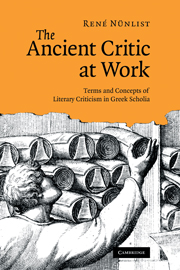Book contents
- Frontmatter
- Contents
- Acknowledgments
- Introduction
- PART I
- PART II
- 13 The gods in Homer
- 14 Homeric similes
- 15 Epithets
- 16 Type scenes
- 17 Homeric speeches
- 18 Reverse order
- 19 Staging, performance and dramaturgy
- Epilogue
- Glossary of Greek terms
- Editions of scholia
- Other abbreviations
- Bibliography
- Thematic index
- Index locorum
19 - Staging, performance and dramaturgy
Published online by Cambridge University Press: 29 August 2009
- Frontmatter
- Contents
- Acknowledgments
- Introduction
- PART I
- PART II
- 13 The gods in Homer
- 14 Homeric similes
- 15 Epithets
- 16 Type scenes
- 17 Homeric speeches
- 18 Reverse order
- 19 Staging, performance and dramaturgy
- Epilogue
- Glossary of Greek terms
- Editions of scholia
- Other abbreviations
- Bibliography
- Thematic index
- Index locorum
Summary
Unlike editions of modern plays, ancient dramatic texts were extremely laconic when it came to providing the reader with crucial information such as the identification of the various speakers, stage directions of all sorts, descriptions of the scene, etc. At an early stage readers were given little more than the bare text and were apparently expected to supply all the other pieces of information themselves by inferring them from the text. However, the limits of this system made themselves increasingly felt, and readers started, for example, to identify the speakers in the margins and between the lines. Not only had it become increasingly clear that this type of information was vital for a proper understanding of the plays, but the laconic presentation of the early manuscripts also led to a considerable amount of confusion and disagreement. As a result, the extant corpus of scholia contains numerous traces of ancient discussions and explanations.
IDENTIFICATION OF SPEAKERS AND ADDRESSEES
The easiest and most common way of identifying the speaker is an abbreviation of the character's name in the margins or interlinear space of the manuscript. However, the scholia, too, explicitly identify the speaker with some frequency. A scholion on Wasps (schol. Ar. V. 174a), for example, indicates that the line in question is spoken by ‘one of the slaves’ (εἷς τῶν οἰκετῶν).
- Type
- Chapter
- Information
- The Ancient Critic at WorkTerms and Concepts of Literary Criticism in Greek Scholia, pp. 338 - 365Publisher: Cambridge University PressPrint publication year: 2009



